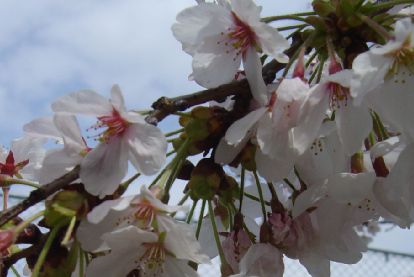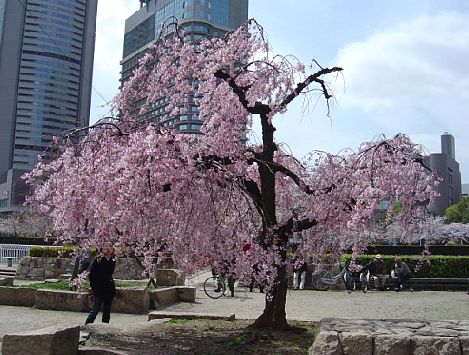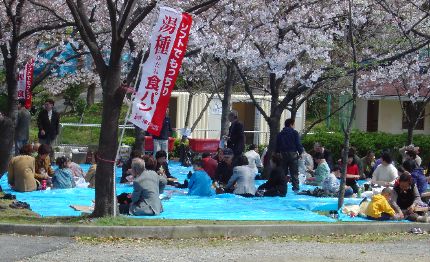| Noticias |
Cherry Blossoms
por Raphael
 One of the most important events on the Japanese calendar is the arrival of spring, which is marked by thousands upon thousands of cherry trees bursting into bloom across the country. For centuries, people have flocked to parks and temples to enjoy the fantastic sight of so many trees all in flower together. The cherry tree is central to Japanese culture: the wood is used for crafts, the petals are used in foods and the emblem of the flower is commonly used as a design motif, on everything from kimonos to good luck charms. The cherry blossom, or ‘sakura’ is without doubt Japan’s best loved flower.
One of the most important events on the Japanese calendar is the arrival of spring, which is marked by thousands upon thousands of cherry trees bursting into bloom across the country. For centuries, people have flocked to parks and temples to enjoy the fantastic sight of so many trees all in flower together. The cherry tree is central to Japanese culture: the wood is used for crafts, the petals are used in foods and the emblem of the flower is commonly used as a design motif, on everything from kimonos to good luck charms. The cherry blossom, or ‘sakura’ is without doubt Japan’s best loved flower.
The cherry blossoms begin to open in January on the hills of Okinawa in the far south of the country. Soon, spring makes its way onto the mainland, passing through Shikoku and Kyushu, and by April the cherry blossoms are open in famous places like Kyoto’s Hirono Shrine, in the middle of the country. Finally, in May, the trees in Hokkaido in the far north of the country have blossomed. Each area has its own variety of ‘sakura’ and there are over 300 different types throughout the country. The phenomenon of the cherry blossom is so important to Japanese culture that when they start to bloom it makes the national news! The gradual, northwards spread of opening trees is known as the ‘cherry blossom front’, and viewers are regularly updated with the best places to go and experience ‘full bloom’ at any one time. This is important, as ‘full bloom’ – the moment when the trees are at their most spectacular – lasts only a week before the petals start to drop.
 There are many places which are considered to be especially good for cherry blossom viewing. In Nara, over 30,000 cherry trees color the hillsides, while Kotahiragu Shrine in Shikoku has over 3000 trees on its grounds. There are even famous trees; one in Gifu Prefecture is over 1500 years old. You don’t have to head to a famous spot though as almost every park and public garden has a cherry tree plantation, and these are the venue for one of the most eagerly awaited events of the social calendar – the cherry blossom viewing or ‘hanami’ party.
There are many places which are considered to be especially good for cherry blossom viewing. In Nara, over 30,000 cherry trees color the hillsides, while Kotahiragu Shrine in Shikoku has over 3000 trees on its grounds. There are even famous trees; one in Gifu Prefecture is over 1500 years old. You don’t have to head to a famous spot though as almost every park and public garden has a cherry tree plantation, and these are the venue for one of the most eagerly awaited events of the social calendar – the cherry blossom viewing or ‘hanami’ party.
The hanami parties were once a privilege of rich noblemen, who drank and wrote poetry in their palaces under the canopy of the cherry blossoms. One famous party, held at Daigoji in Kyoto by a warlord called Hideyoshi to celebrate his victory in the civil war, is reenacted every year with a large parade. These days though, ordinary folk are just as likely to hold a hanami party and almost every family, office and school will do so. It is a wonderful social occasion. People bring picnics and games and drink together among the blossoming petals. These events are planned months in advance, and very often someone will be given the day off work to go and sit in the park in order to secure a prime spot for the cherry blossom party. Go into any park during the cherry blossom season and you will experience a fantastic atmosphere.

It is not simply the aesthetic beauty of the cherry blossom that makes it so important to Japanese culture, however. There is something in the short lived nature of the spectacle that the Japanese consider to be important also. Almost as soon as the petals have opened, they are drifting to the ground in the breeze. This, many Japanese say, reminds us of our mortality; that our life is short and should be appreciated while it is here. The ephemeral nature of the cherry blossom can be seen as central to the Japanese world view.
Just as the cherry tree has a spiritual significance for Japanese people, it has many practical uses as well. The wood is strong and has a natural sheen, making it an ideal material for high end furniture. The bark is also strong and can be cut into strips which are used to protect musical instruments. The leaves of the tree are edible and are used to wrap rice cakes, their bitter taste contrasting strongly with the sweet inside. The petals are also considered a delicacy. Preserved in salt, they are added to hot water to make a delicate tea, which can be drunk alongside sweets in the shape of cherry blossoms. And finally, the emblem of the cherry blossom can be found on countless items in gift shops throughout the country, such as lacquer bowls and boxes.
However, the cherry tree is in danger! Towards the beginning of the twentieth century it was discovered that it was possible to cross breed species of cherry trees. This was successfully done to create a new type of tree called Somei Yoshino. This tree would grow faster than other variety, while producing a bigger flower. However, many of these trees are now becoming diseased, and are producing much less blossom than before. The problem is that the new type of tree is sterile, and unable to produce seeds. All new Somei Yoshino trees are therefore clones, and are unable to adapt successfully to changes in the environment. Therefore, park rangers are being taught special ways to look after the trees. They thin and prune the branches, helping to stimulate new growth, and they replace old soil and remove diseased roots. With this careful management, trees over 120 years old are preserved - an important achievement as the cherry blossom is without doubt one of the most iconic elements of Japanese culture.
| Aucun commentaire |


















